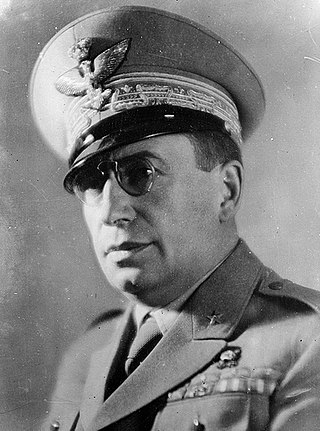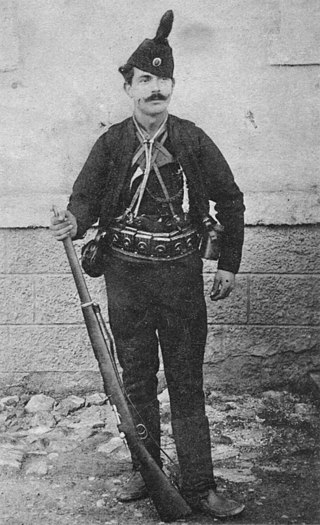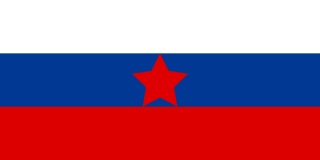
The Chetniks, formally the Chetnik Detachments of the Yugoslav Army, and also the Yugoslav Army in the Homeland and the Ravna Gora Movement, was a Yugoslav royalist and Serbian nationalist movement and guerrilla force in Axis-occupied Yugoslavia. Although it was not a homogeneous movement, it was led by Draža Mihailović. While it was anti-Axis in its long-term goals and engaged in marginal resistance activities for limited periods, it also engaged in tactical or selective collaboration with Axis forces for almost all of the war. The Chetnik movement adopted a policy of collaboration with regard to the Axis, and engaged in cooperation to one degree or another by both establishing a modus vivendi and operating as "legalised" auxiliary forces under Axis control. Over a period of time, and in different parts of the country, the movement was progressively drawn into collaboration agreements: first with the puppet Government of National Salvation in the German-occupied territory of Serbia, then with the Italians in occupied Dalmatia and Montenegro, with some of the Ustaše forces in northern Bosnia, and, after the Italian capitulation in September 1943, with the Germans directly.

The Bleiburg repatriations were a series of forced repatriations from Allied-occupied Austria of Axis-affiliated individuals to Yugoslavia in May 1945 after the end of World War II in Europe. During World War II, Yugoslavian territory was either annexed or occupied by Axis forces, and as the war came to end, thousands of Axis soldiers and civilian collaborators fled Yugoslavia for Austria as the Yugoslav Army (JA) gradually retook control. When they reached Austria, in accordance with Allied policy, British forces refused to take them into custody and directed them to surrender to the JA instead. The JA subsequently subjected them to death marches back to Yugoslavia, where those who survived were either subject to summary executions or interned in labor camps, where many died due to harsh conditions. The repatriations are named for the Carinthian town of Bleiburg, where the initial British refusal to accept the surrenders occurred, and from which some repatriations were carried out.

The Yugoslav Partisans, or the National Liberation Army, officially the National Liberation Army and Partisan Detachments of Yugoslavia, was the communist-led anti-fascist resistance to the Axis powers in occupied Yugoslavia during World War II. Led by Josip Broz Tito, the Partisans are considered to be Europe's most effective anti-Axis resistance movement during World War II.

The Slovene Home Guard, was a Slovene anti-Partisan collaborationist militia that operated during the 1943–1945 German occupation of the formerly Italian-occupied Slovene Province of Ljubljana. The Guard consisted of former Village Sentries, part of Italian-sponsored Anti-Communist Volunteer Militia, re-organized under Nazi command after the Italian Armistice of September 1943.

World War II in the Kingdom of Yugoslavia began on 6 April 1941, when the country was invaded and swiftly conquered by Axis forces and partitioned among Germany, Italy, Hungary, Bulgaria and their client regimes. Shortly after Germany attacked the USSR on 22 June 1941, the communist-led republican Yugoslav Partisans, on orders from Moscow, launched a guerrilla liberation war fighting against the Axis forces and their locally established puppet regimes, including the Axis-allied Independent State of Croatia (NDH) and the Government of National Salvation in the German-occupied territory of Serbia. This was dubbed the National Liberation War and Socialist Revolution in post-war Yugoslav communist historiography. Simultaneously, a multi-side civil war was waged between the Yugoslav communist Partisans, the Serbian royalist Chetniks, the Axis-allied Croatian Ustaše and Home Guard, Serbian Volunteer Corps and State Guard, Slovene Home Guard, as well as Nazi-allied Russian Protective Corps troops.

Mario Roatta was an Italian general. After serving in World War I he rose to command the Corpo Truppe Volontarie which assisted Francisco Franco's force during the Spanish Civil War. He was the Deputy Chief of Staff of the Italian Army from October 1939 to March 1941 and from March 1941 to January 1942 its Chief of Staff and helped in preparing for the invasion of Yugoslavia.

Ilija Trifunović-Birčanin was a Serbian Chetnik military commander. He took part in the Balkan Wars and World War I and afterwards served as the president of the Association of Serb Chetniks for Freedom and the Fatherland in the Kingdom of Yugoslavia. In the spring of 1942, he was appointed by Mihailović as the commander of Chetniks in Dalmatia, Herzegovina, western Bosnia and southwestern Croatia. He died in Split on 3 February 1943, having suffered from poor health for a considerable period of time.

Ernest Peterlin was a Slovene military officer who rose to a senior position in the Royal Yugoslav Army prior to the Second World War. Married to Anja Roman Rezelj. A decided anti-Communist, during the war he became a prominent anti-Partisan military leader and one of the main exponents of the pro-Western faction of the Slovene Home Guard, an anti-Communist collaborationist militia active in parts of German-occupied Slovenia between 1943 and 1945. In 1945, he was tried and sentenced to death by the new Yugoslav Communist authorities and executed in 1946.

The Anti-Communist Volunteer Militia were paramilitary auxiliary formations of the Royal Italian Army composed of Yugoslav anti-Partisan groups in the Italian-annexed and occupied portions of the Kingdom of Yugoslavia during the Second World War.

Marko Natlačen was a Slovenian politician and jurist, who also served as the last ban (governor) of the Drava Banovina in the Kingdom of Yugoslavia. His assassination at the hands of the Slovenian Communist secret police (VOS) during World War II was an important event in the escalation of the armed conflict between the Slovenian partisans and the Slovenian paramilitary anti-revolutionary forces in the Province of Ljubljana. The role of Natlačen during World War II and the extent to which he collaborated with the Fascist Italian forces has been disputed.

The 369th (Croatian) Infantry Division was a legionary division of the German Army (Wehrmacht) during World War II.

The Slovene Partisans, formally the National Liberation Army and Partisan Detachments of Slovenia, were part of Europe's most effective anti-Nazi resistance movement led by Yugoslav revolutionary communists during World War II, the Yugoslav Partisans. Since a quarter of Slovene ethnic territory and approximately 327,000 out of total population of 1.3 million Slovenes were subjected to forced Italianization since the end of the First World War, the objective of the movement was the establishment of the state of Slovenes that would include the majority of Slovenes within a socialist Yugoslav federation in the postwar period.

Vojislav Lukačević was a Serbian Chetnik commander in the Kingdom of Yugoslavia during World War II. At the outbreak of war, he held the rank of captain of the reserves in the Royal Yugoslav Army.

Petar Baćović was a Bosnian Serb Chetnik commander within occupied Yugoslavia during World War II. From the summer of 1941 until April 1942, he headed the cabinet of the Ministry of Internal Affairs for Milan Nedić's puppet Government of National Salvation in the German-occupied territory of Serbia. In May and June 1942, Baćović participated in the joint Italian-Chetnik offensive against the Yugoslav Partisans in Montenegro In July 1942, Baćović was appointed by the Chetnik leader Draža Mihailović and his Supreme Command as the commander of the Chetnik units in the regions of eastern Bosnia and Herzegovina within the Axis puppet state, the Independent State of Croatia. In this role, Baćović continued collaborating with the Italians against the Yugoslav Partisans, with his Chetniks formally recognised as Italian auxiliaries from mid-1942.

Lieutenant Colonel Zaharije Ostojić was a Montenegrin Serb and Yugoslav military officer who served as the chief of the operational, organisational and intelligence branches of the Chetnik Supreme Command led by Draža Mihailović in Yugoslavia during World War II. He was a major in the Royal Yugoslav Army Air Force prior to the Axis invasion of Yugoslavia, and was involved in the coup that deposed Prince Paul of Yugoslavia on 27 March 1941. After the coup, he escorted Prince Paul to exile in Greece, and was in Cairo during the invasion in April. In September 1941, he was landed on the coast of the Italian governorate of Montenegro along with the British Special Operations Executive officer Captain Bill Hudson and two companions. He escorted Hudson to the German-occupied territory of Serbia and introduced him to the Yugoslav Partisan leader Josip Broz Tito at Užice, then accompanied Hudson to Ravna Gora to meet Mihailović. Ostojić soon became Mihailović's chief of staff, and after the German attempt to capture the Chetnik leader during Operation Mihailovic in December 1941, brought the Chetnik Supreme Command staff to Montenegro where they were re-united with Mihailović in June 1942. During the remainder of 1942, Ostojić launched a counter-attack against Ustaše troops of the Independent State of Croatia returning to the eastern Bosnian town of Foča where they were expected to continue their genocidal anti-Serb policies. As many as 2,000 local Muslims were subsequently killed in the town by forces under Ostojić's command. Ostojić later oversaw large-scale massacres of civilians and burning of Muslim villages in the border region between Montenegro and the Sandžak.
Bajo Stanišić was a Montenegrin Serb officer of the Royal Yugoslav Army, who was one of the participants of the Uprising in Montenegro against the Italian occupation forces in 1941. After the suppression of the uprising, he became one of the commanders of the Chetnik units in Montenegro and openly collaborated with Fascist Italy until his death in 1943.

The Blue Guard, also known as the Slovene Chetniks, was a Slovenian anti-communist militia, initially under the leadership of Major Karl Novak and later Ivan Prezelj. Their official name was the Royal Yugoslav Army in Slovenia.
The Battle of Grčarice was a battle fought in early September 1943 between the Slovene Partisans and the Blue Guard. The battle was waged in Grčarice in German-occupied Yugoslavia, modern-day Slovenia.

Jože Melaher - Zmagoslav (1913-1991) was Yugoslav military officer, most notable for being commander of Chetnik Štajerska detachment during the World War II.

Vuk Rupnik was a Slovene military officer during the Second World War.

















